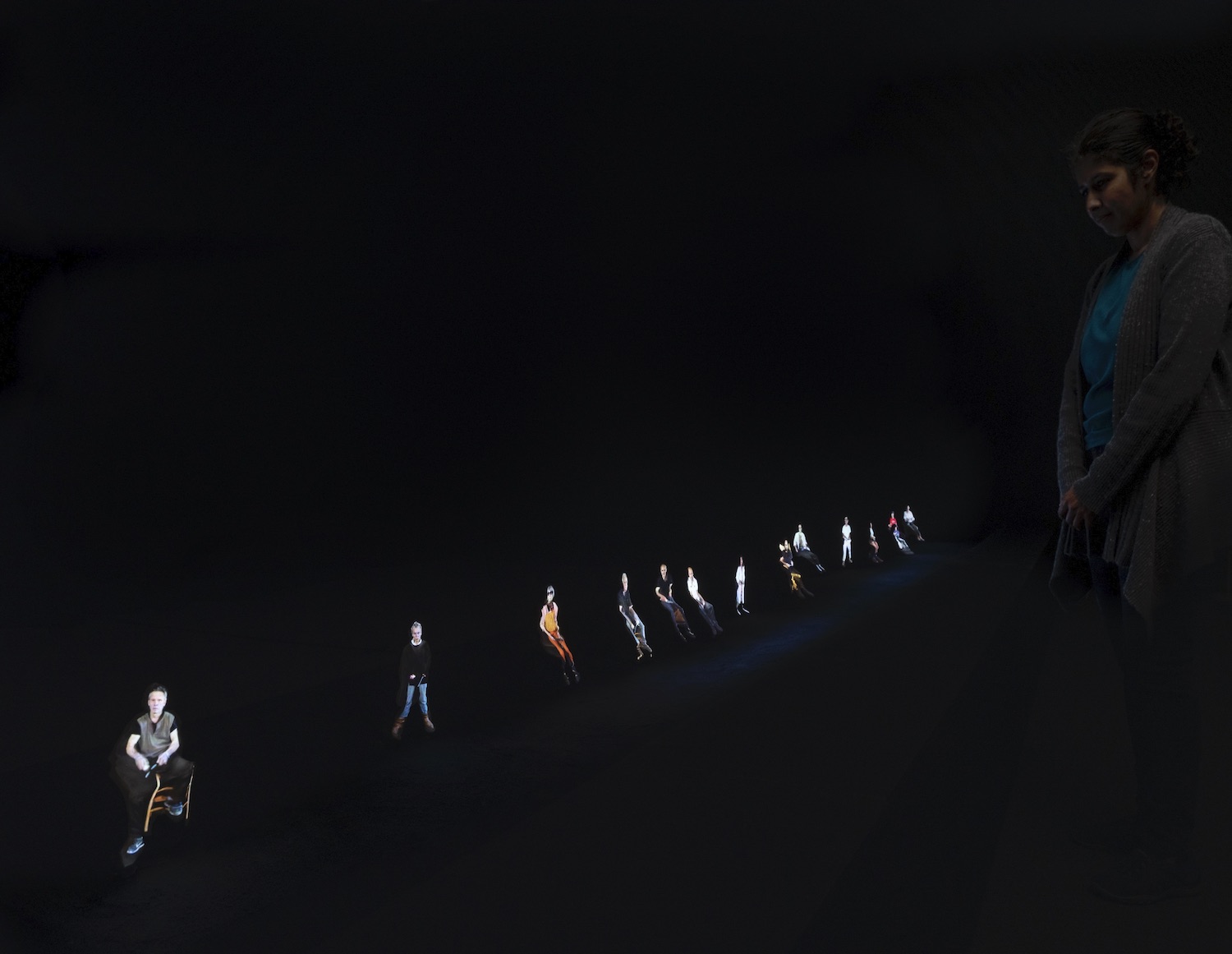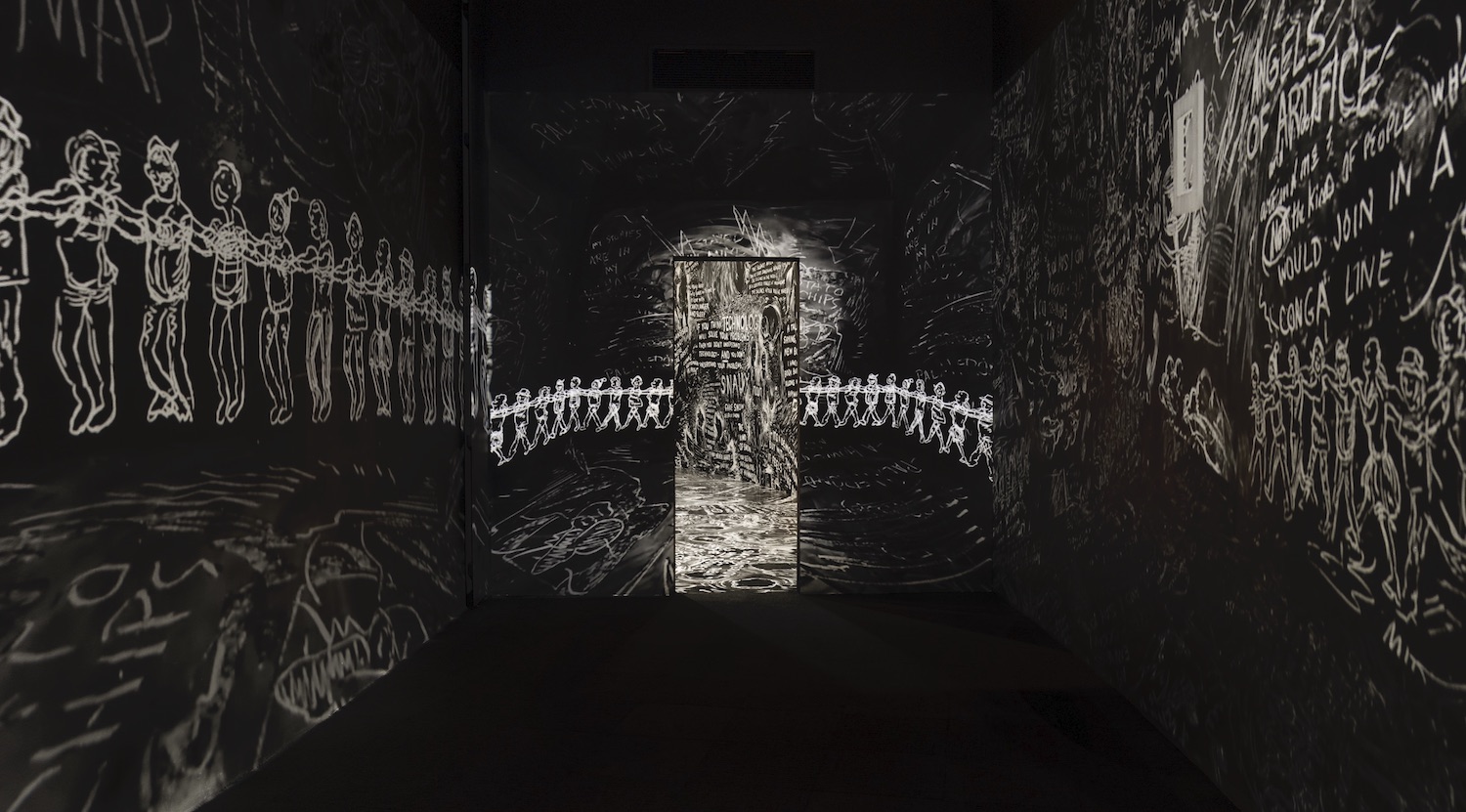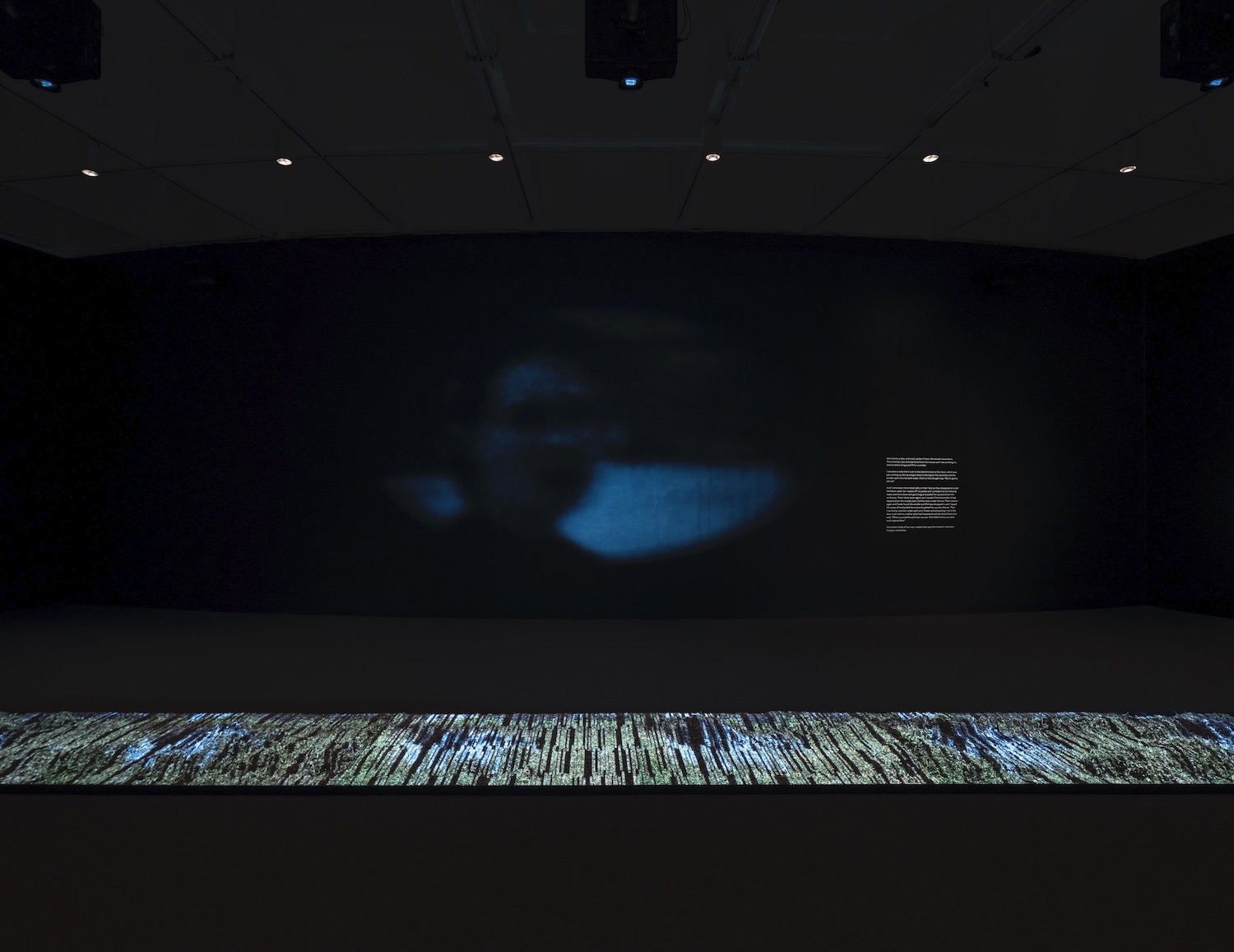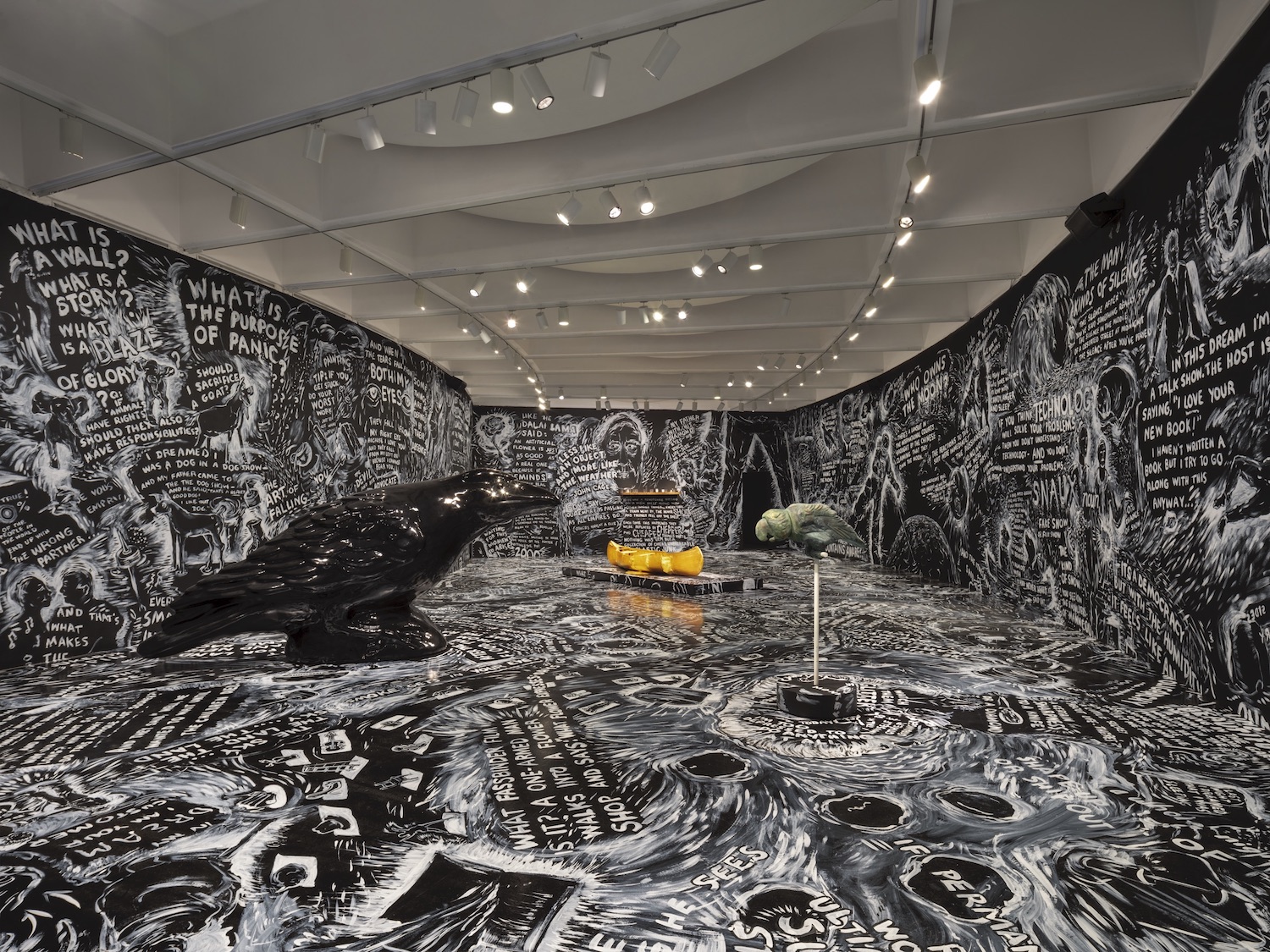“Laurie Anderson: The Weather” at the Hirshhorn Museum and Sculpture Garden is the largest US exhibition of Anderson’s work to date. At 74, Anderson continues to be immensely creative as multimedia artist, performer, musician and writer—the show includes more than a dozen new works. A storyteller first and foremost, Anderson is an astute observer and interpreter, who gathers together threads of information from personal history, news reports, natural phenomena, human behavior and so on, weaving these together into simple stories, loaded with power.
One of her most potent, A Story about a Story (2015) is a stand-alone tale printed on a wall panel; it describes how Anderson, as a child of 12, broke her back while trying to perform a flip off the high diving board at a pool. She missed the water, hitting the concrete instead and was confined for several months to a hospital. The story is about how we remember things and what we choose to forget, or forget because what we went through is too traumatic to deal with. In this story of the spunky kid trying to stick out from the crowd of seven siblings by doing daring things, you can see the nascent fearless impresario who’d grow up to dazzle audiences. It’s not just a story that she buried deep within her subconscious about the horrors of the hospital ward where Anderson was kept awake at night by the screams of dying children, it’s also, in effect, Anderson’s Rosebud.

A Story about a Story on view in “Laurie Anderson: The Weather,” 2021. Photo credit: Ron Blunt. Hirshhorn Museum and Sculpture Garden.
Another anecdote from Anderson’s childhood forms the basis of The Lake (2015/2021). This time, it’s paired with a grainy black-and-white film of kids skating. The footage, projected in oval vignette form, feels antique and nostalgic. It’s blurry and indistinct like an ancient memory reeling through one’s mind. Accompanying text describes how as a young girl Anderson saved her younger twin brothers from the depths of a frozen lake. The near-tragedy is shocking. In Anderson’s telling she astringently conveys her own curiosity and mettle, her role in her family and her relationship with her mother.
It’s no wonder that words, the building blocks of the stories Anderson tells, feature prominently in her work. She loves the sound of them, their meaning and even how they look: scrawled, printed, computer generated, shredded or broken down into individual letters.
Technology is a major preoccupation. Anderson both embraces it, using all sorts of devices and experimental musical instruments in her performance work—voice filters, synthesizers, adapted violins, etc.—some of which she has invented or collaborated on. But Anderson is also wary of technology and its dehumanizing potential. Her book Scroll (2021) speaks to this. Composed of text generated by artificial intelligence using a combination of Anderson’s writings and The Bible, the end product has decipherable meaning, but is very strange and rather unsettling.

Citizens on view in “Laurie Anderson: The Weather,” 2021. Photo credit: Ron Blunt. Hirshhorn Museum and Sculpture Garden.
Habeas Corpus (2015) is certainly an important piece (and an important piece to show in Washington DC) given its focus on the injustices being perpetrated by the United States government. The piece centers on Mohammed el Gharani, who at age 14 became the youngest prisoner held without charge at Guantanamo. The original version, at the Park Avenue Armory in New York, was live and featured a two-way camera. Not only did this allow el Gharani to see the visitors and their response to him, but visitors and subject shared this intense, human, real-time event. That electrifying element is absent in this version and I didn’t like the way the oversized blocky statue distorted the film of el Gharani so he appeared deformed. It was distracting and undercut the solemnity of the work. You didn’t notice this distortion in Anderson’s similar small-scale film-sculpture hybrids and they are far more successful. The figures in these actually look like three-dimensional people in miniature. From the Air (2009) which features Anderson and her dog, Lolabelle, sitting in side-by-side armchairs is one such example. The Anderson figure describes the walk they took in California when Lolabelle first encountered large birds of prey and how the dog’s reaction echoed in her memory. Another is the mesmerizing Citizens (2021) with its bright row of individuals who stare confrontationally at the viewer while rhythmically striking a pinging knife against a whetstone.

From the Air on view in “Laurie Anderson: The Weather,” 2021. Photo credit: Ron Blunt. Hirshhorn Museum and Sculpture Garden.
Four Talks (2021) features an enormous site-specific painting of graffiti-like scrawls of text and images (all done single-handedly by Anderson in the weeks leading up to the opening) that covers the floor and four walls of a large room. The written musings of facts and sayings and the drawings have an edgy urgency; they seem to blare at you from around the room. A soundtrack plays music, nature and animal sounds and Anderson’s voice. Four sculptures are positioned around the room. These include two over-sized birds, a raven, The Witness Protection Program (2020), and an extremely talkative parrot, My Day Beats Your Year (2010/2021). There’s also a wrecked gilt canoe, To Carry Heart’s Tide (2020), over which Anderson ponders, “How can you fix something that’s really broken?”
On one wall, What Time Can Do (2021), a meditation on substitution and desire, features a shelf arrayed with fragile objects. Every now and then the recorded clackety-clack of a train going by shakes the objects on the shelf. The piece was inspired by a friend of Anderson’s who lived near the train. She had a collection of porcelain tchotchkes on a shelf and when the train went by, the shelf shook. Eventually, one by one, the precious objects were dislodged and fell to the ground. The friend would replace the broken ones with less and less valuable pieces until there was nothing on the shelf but junk.

Chalkroom on view in “Laurie Anderson: The Weather,” 2021. Photo credit: Ron Blunt. Hirshhorn Museum and Sculpture Garden.
The sculptures add a three-dimensional element to the space, making the whole more visually interesting. They also suggest possible relationships amongst them and with the words and images of their backdrop. However, I was so astonished by the painting, it monopolized all my attention. I made a point of retracing my steps back to the hallway leading into the room where Chalkroom (2017) (a collaboration with Hsin-Chien Huang) is projected on the walls. Originally a virtual reality piece, it was reformatted because of COVID-19 restrictions. Though not as immersive as wearing VR goggles, the effect aptly simulates 3D space and is, at points, thrillingly disorienting and vertiginous. You don’t notice it during your first walk-through, but placed where it is, it’s the perfect companion to Four Talks which is visible through the doorway. Chalkroom uses the same black-and-white scrawled words and images with some notable additions: the conga line of stick figures, a tree boasting letters instead of leaves that fall to the ground as the motion of the film shifts downwards. The footage is so densely packed, it’s hard to absorb all the information, the flood of images and words, perhaps a stand-in for the assault of information we encounter in our everyday lives. It’s an odd funhouse space with long corridors, portals and opposing planes of chalkboard that fragment and fall apart. Letters float towards you like driving snow or stars streaming past a rocket ship. Your position as viewer has shifted and now you are not just observing, you are moving through it. And as you stand there looking into the other room, you have the sensation that the scrawled writing and pictures that cover the walls and floor of the Four Talks room have become animated and are streaming outwards into the hallway towards you.

Salute on view in “Laurie Anderson: The Weather,” 2021. Photo credit: Ron Blunt. Hirshhorn Museum and Sculpture Garden.
Some of the new works, though certainly stylish, don’t seem to have a lot of there, there. Salute (2021) is arresting with its scarlet flags on robotic arms that snap and scrape the floor, but even with the ominous background music and lyrics to O Superman (1981) and its reference to “electronic arms” enlarged on one wall, its seeming swipe at nationalist authoritarianism feels hollow. Likewise, Wind Book (1974/2021) with its fluttering pages manipulated by hidden fans, is pretty cool, but to what end? Neither piece has a story attached to it and perhaps this is why they seem less compelling. However, there are others that also don’t, Citizens (2021) and Sidewalk (2012), for example. But these works have such presence they don’t need a story to complete them. To be fair, Sidewalk does have a tangential relationship to A Story about a Story. The work features a long rectangular container, resembling a section of sidewalk, that’s filled with shredded pages of Dostoevsky’s Crime and Punishment. A series of videos is projected in opposite directions on each of the rectangles that make up the “sidewalk.” The paper bits create a topographical expanse of mountains and valleys which distort the film. Much of it is indecipherable, but every now and then one can see in the flickering clips nurses, swimmers at a pool, an old farm, images that relate to Anderson’s personal history.

Sidewalk on view in “Laurie Anderson: The Weather,” 2021. Photo credit: Ron Blunt. Hirshhorn Museum and Sculpture Garden.
Included in the exhibition are a series of Anderson’s paintings. These are large, lushly painted works. Against a background of thinly applied color, Anderson places gestural swirling lines that add energy and describe an overscale item: an old work boot, an alligator, a face, a tree. Though perfectly respectable in terms of technique, the paintings are kind of meh when compared to the pizzazz and inventiveness of her multimedia work.
At times “Laurie Anderson: The Weather” seems like a retrospective. The show includes very early performance pieces, posters from her live shows, and a large selection of the musical instruments she either made herself, collaborated on, or commissioned. These are placed near the end of the exhibition, possibly to subvert the sense of linear progression, but their presence still suggests an overview of her career. Anderson has made it clear in several interviews that she didn’t want a retrospective and, looking around at “The Weather,” it’s clear she’s not done yet.
At other times, the show seems like a random collection of works. I felt I was taking a stream of consciousness walk through Anderson’s mind as she played around with ideas, but I can imagine few things more interesting and engaging. While she seems unnervingly prescient at times, I believe Anderson’s just a really good observer, who picks up on things long before the rest of us and then puts her own particular spin on them. Her observations about the world enthrall us because it’s a world we inhabit and recognize. Anderson is our guide and her person is inextricably tied to the work. To experience it is to experience her—her intelligence, her humanity, her wonder, her goodwill, her can-do attitude, her humor. A Midwestern soul sister to Harper Lee’s Scout, Anderson resembles an ageless sprite who cajoles us into consciousness with work that provokes, informs and entertains. With the Hirshhorn show, Anderson demonstrates that much like the weather, her works and the information they are based on, are arbitrary and unpredictable, and like that overarching atmospheric phenomenon, they’re also capable of buffeting us with terrific force.
“Laurie Anderson: The Weather,” curated by Marina Isgro, Robert and Arlene Kogod and Mark Beasley, at The Hirshhorn Museum, Washington D.C., runs through July 31, 2022.


